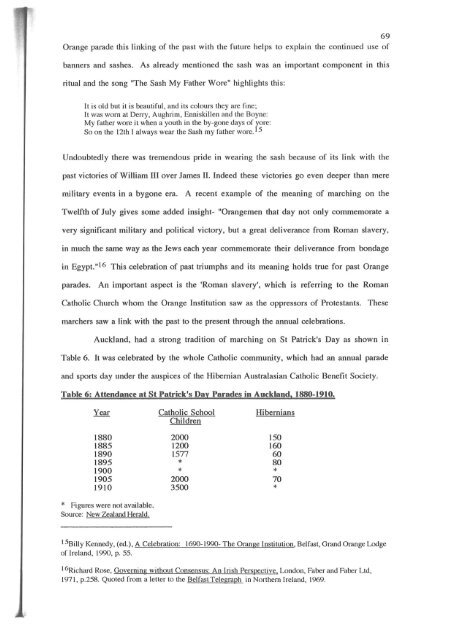TRANSPLANTED IRISH INSTITUTIONS - University of Canterbury
TRANSPLANTED IRISH INSTITUTIONS - University of Canterbury
TRANSPLANTED IRISH INSTITUTIONS - University of Canterbury
You also want an ePaper? Increase the reach of your titles
YUMPU automatically turns print PDFs into web optimized ePapers that Google loves.
69<br />
Orange parade this linking <strong>of</strong> the past with the future helps to explain the continued use <strong>of</strong><br />
banners and sashes. As already mentioned the sash was an important component in this<br />
ritual and the song "The Sash My Father Wore" highlights this:<br />
It is old but it is beautiful, and its colours they are fine;<br />
It was worn at Derry, Aughrim, Enniskillen and the Boyne:<br />
My father wore it when a youth in the by-gone days <strong>of</strong> yore:<br />
So on the 12th I always wear the Sash my father wore. 15<br />
Undoubtedly there was tremendous pride in wearing the sash because <strong>of</strong> its link with the<br />
past victories <strong>of</strong> William III over James II. Indeed these victories go even deeper than mere<br />
military events in a bygone era. A recent example <strong>of</strong> the meaning <strong>of</strong> marching on the<br />
Twelfth <strong>of</strong> July gives some added insight- "Orange men that day not only commemorate a<br />
very significant military and political victory, but a great deliverance from Roman slavery,<br />
in much the same way as the Jews each year commemorate their deliverance from bondage<br />
in Egypt. "16 This celebration <strong>of</strong> past triumphs and its meaning holds true for past Orange<br />
parades. An important aspect is the 'Roman slavery', which is referring to the Roman<br />
Catholic Church whom the Orange Institution saw as the oppressors <strong>of</strong> Protestants. These<br />
marchers saw a link with the past to the present through the annual celebrations.<br />
Auckland, had a strong tradition <strong>of</strong> marching on St Patrick's Day as shown in<br />
Table 6. It was celebrated by the whole Catholic community, which had an annual parade<br />
and sports day under the auspices <strong>of</strong> the Hibernian Australasian Catholic Benefit Society.<br />
Table 6: Attendance at St Patrick's Day Parades in Auckland, 1880-1910.<br />
*<br />
Year Catholic School Hibernians<br />
Children<br />
1880 2000 ISO<br />
1885 1200 160<br />
1890 1577 60<br />
1895 * 80<br />
1900 * *<br />
1905 2000 70<br />
1910 3500 *<br />
Figures were not available.<br />
Source: New Zealand Herald.<br />
15Billy Kennedy, (ed.), A Celebration: 1690-1990- The Orange Institution, Belfast, Grand Orange Lodge<br />
<strong>of</strong> Ireland, 1990, p. 55.<br />
16Richard Rose, Governing without Consensus: An Irish Perspective, London, Faber and Faber Ltd,<br />
1971, p.258. Quoted from a letter to the Belfast Telegraph in Northern Ireland, 1969.
















